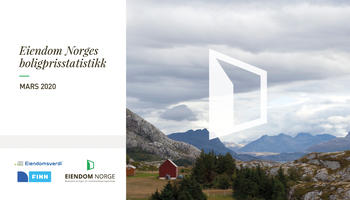
Big differences in housing price developments in July
House prices fell by 1.1 per cent in July 2023. Adjusted for seasonal variations, house prices rose by 0.2 per cent.
So far this year, house prices in Norway have risen by 5.2 per cent.
The average price for a home in Norway was NOK 3,944,271 at the end of July.
- House prices fell by 1.1 per cent in July, which resulted in a slight increase of 0.2 per cent in the seasonally adjusted prices, says managing director Henning Lauridsen of Eiendom Norge.
- In July, there were big differences in house price development, and the national development is drawn up by a very strong development in Kristiansand and Stavanger and a strong development in Oslo. In Bergen, the development was particularly weak, he says.
- We expect a weaker development in housing prices going forward. It is common for house prices to rise a lot in August, but an element of uncertainty now is the double interest rate increase from June. The one that will hit the banks' lending rates in August. It will affect house prices on the downside, he says.
- When the key interest rate has tripled in the past year, we believe Norges Bank should now keep the interest rate steady and await the effects of previous interest rate increases. The interest rate works with a significant delay in the economy, and the weak new home sales in the past year is a warning of weaker development in the Norwegian economy going forward, says Lauridsen.
Normal activity in July
In July, 4,134 homes were sold in Norway, which is 1.6 per cent more than the corresponding month in 2022.
So far this year, 54,908 homes have been sold in Norway, which is 2.1 per cent more than in the same period in 2022.
In July, 3,667 homes were put up for sale in Norway, which is 13.8 per cent more than in the same month in 2022.
So far this year, 60,451 homes have been let in Norway, which is 5.7 per cent more than in the same period in 2022.
- There has been somewhat greater activity in the second-hand housing market in July this year than last year. The increase is mainly due to more sales in Oslo, says Lauridsen.
It took an average of 47 days to sell a home in July, up from 30 days in June. Oslo had the shortest sales time with 27 days. Tromsø and Follo had the longest sales time with 68 days.
The interest rate should be kept stable
Kristiansand had the strongest seasonally adjusted price development in July, where prices rose by 1.5 per cent, followed by Stavanger and its surroundings by 1.4 per cent.
Bergen had the weakest seasonally adjusted price development, with a seasonally adjusted decrease of 2.9 per cent.
The strongest development so far in 2023 is in Kristiansand and Stavanger and its surroundings, with an increase of 10.7 and 9.9 per cent. The weakest development so far this year is Tromsø with an increase of 0.7 per cent.
- House price trends in Southern Norway, South-Western Norway and Oslo stand out, both last month and so far this year. At the opposite end is Bergen last month and Tromsø so far this year.
- The interest rate works differently in different parts of the country. The south and south-west of Norway have had a weak development in house prices for many years, which gives great potential for house price growth. Now prices are being pushed up by increased activity in the business world, and interest rates therefore do not bite as much here as in other parts of the country. In Oslo, low housing construction over many years trumps the increased interest rate, despite very high prices in the capital, says Lauridsen.
- New home sales have plummeted in the last year, despite great needs, as shown by the strong growth in rental property prices. Throughout the summer, we have also seen bankruptcies among house builders, and it is probably just the beginning. In our view, Norges Bank is wise to keep interest rates more stable going forward, concludes Lauridsen.






